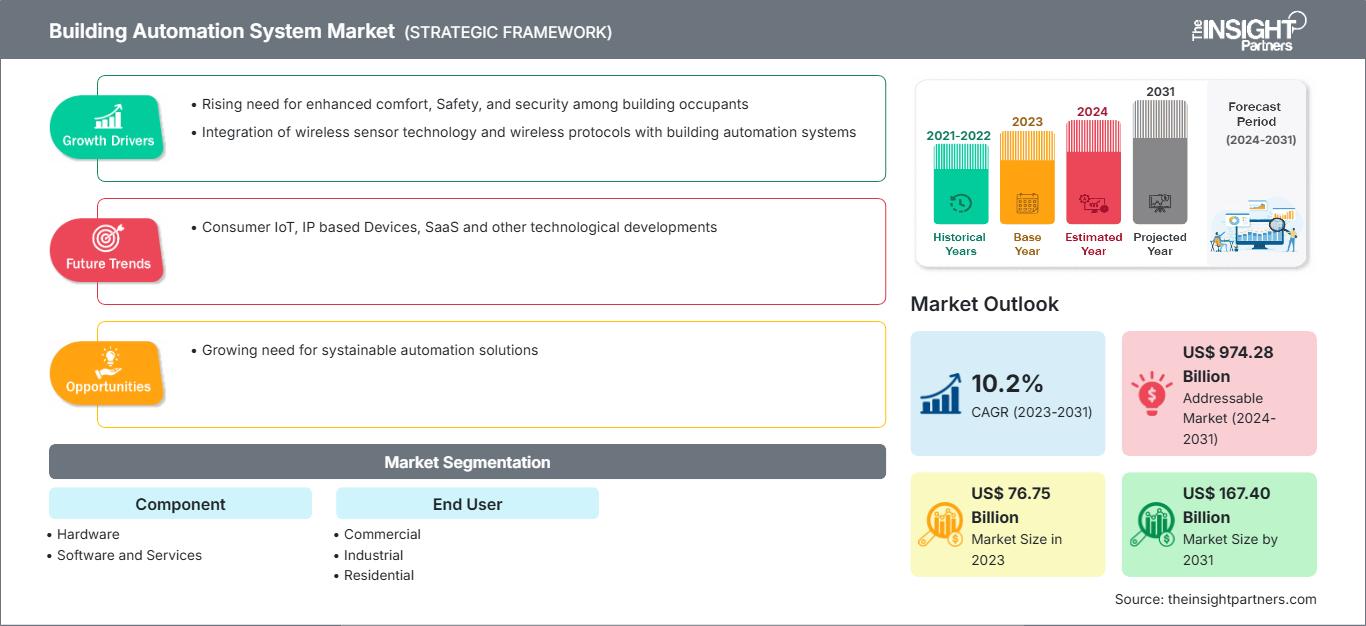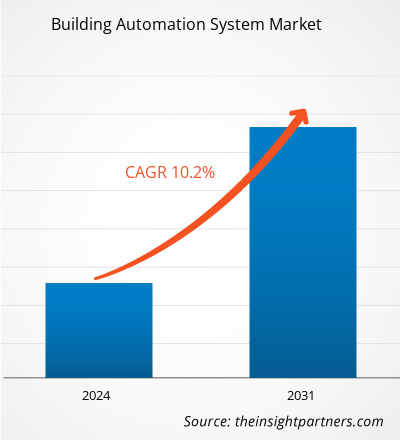Der Markt für Gebäudeautomationssysteme soll von 76,75 Milliarden US-Dollar im Jahr 2023 auf 167,40 Milliarden US-Dollar im Jahr 2031 anwachsen. Für den Zeitraum 2023–2031 wird ein durchschnittliches jährliches Wachstum (CAGR) von 10,2 % erwartet. Consumer-IoT, IP-basierte Geräte, SaaS und andere technologische Entwicklungen bleiben voraussichtlich die wichtigsten Trends auf dem Markt.
Marktanalyse für Gebäudeautomationssysteme
Die zunehmende Bautätigkeit und die steigende Nachfrage nach intelligenten Gebäuden weltweit sind die Hauptfaktoren, die das Marktwachstum ankurbeln. Gebäudeautomationssysteme nutzen hochentwickelte Sensoren, Aktoren und Netzwerktechnologien, um eine zentrale Steuerung und Überwachung von Gebäudesystemen wie Heizung, Lüftung, Klima, Beleuchtung, Sicherheit, Zugangskontrolle und Energiemanagement zu ermöglichen. Diese Technologien sollen die Gebäudeeffizienz maximieren, den Energieverbrauch senken, Facility-Management-Verfahren vereinfachen und die Einhaltung von Vorschriften und Normen gewährleisten, was die Nachfrage auf dem Markt für Gebäudeautomationssysteme weiter steigert. Der technologische Fortschritt, wie die Integration von IoT, IP-basierten Geräten, SaaS, maschinellem Lernen und anderen Technologien, dürfte in den kommenden Jahren ebenfalls neue Trends mit sich bringen.
Marktübersicht für Gebäudeautomationssysteme
Ein Gebäudeautomationssystem (BAS) ermöglicht dem Betreiber den Zugriff, die Steuerung und Überwachung aller angeschlossenen Gebäudesysteme über eine einzige Schnittstelle. Die BAS-Technologie ermöglicht dem Eigentümer die Nutzung vernetzter elektronischer Geräte zur zentralen Verwaltung des Gebäudebetriebs. Um den Komfort der Bewohner zu gewährleisten, regeln die Systeme Belüftung, Luftfeuchtigkeit, Beleuchtung und Temperatur. Anwesenheitssensoren und Zeitschaltuhren tragen dazu bei, Energieverschwendung zu minimieren, indem sie Umweltsysteme bei Nichtgebrauch anpassen. Darüber hinaus wird sichergestellt, dass jedes System mit optimaler Effizienz und Genauigkeit läuft. Betreiber werden durch Sensoren benachrichtigt, wenn vorbeugende Wartung erforderlich ist. Die Brandschutz-, Zugangs- und Überwachungssysteme des Gebäudes sind alle integriert, um die Sicherheit des Gebäudes und seiner Bewohner zu gewährleisten.
Passen Sie diesen Bericht Ihren Anforderungen an
Sie erhalten kostenlos Anpassungen an jedem Bericht, einschließlich Teilen dieses Berichts oder einer Analyse auf Länderebene, eines Excel-Datenpakets sowie tolle Angebote und Rabatte für Start-ups und Universitäten.
Markt für Gebäudeautomationssysteme: Strategische Einblicke

- Holen Sie sich die wichtigsten Markttrends aus diesem Bericht.Dieses KOSTENLOSE Beispiel umfasst Datenanalysen, die von Markttrends bis hin zu Schätzungen und Prognosen reichen.
Sie erhalten kostenlos Anpassungen an jedem Bericht, einschließlich Teilen dieses Berichts oder einer Analyse auf Länderebene, eines Excel-Datenpakets sowie tolle Angebote und Rabatte für Start-ups und Universitäten.
Markt für Gebäudeautomationssysteme: Strategische Einblicke

- Holen Sie sich die wichtigsten Markttrends aus diesem Bericht.Dieses KOSTENLOSE Beispiel umfasst Datenanalysen, die von Markttrends bis hin zu Schätzungen und Prognosen reichen.
Markttreiber und -chancen für Gebäudeautomationssysteme
Steigender Bedarf an mehr Komfort und Sicherheit
Gebäudeautomationssysteme verbessern die Sicherheit von Gebäuden durch modernste Instrumente und Techniken. Sie bieten den Gebäudenutzern mehr Sicherheit und schützen Vermögenswerte, Unternehmensressourcen, Eigentum und IT-Daten. Neben der Verhinderung von Sachschäden und Diebstahl kann das System auch vor Manipulation und Diebstahl durch Mitarbeiter schützen. Das Aufzugszugangskontrollsystem im Gebäude beschränkt den Zugang auf ausgewählte Stockwerke und Bereiche innerhalb des Gebäudes, die vom Management als gesperrt erachtet werden. Darüber hinaus schützt das System vor Sicherheitsverletzungen und ermöglicht die vorübergehende Lenkung des Verkehrs innerhalb der Einrichtung. Durch die Nutzung von Zeit- und Tagesplanungsbeschränkungen im Zugangskontrollmanagement wird nur autorisiertem Personal Zutritt gewährt. Darüber hinaus wird jede Aktivität auf dem Gelände und innerhalb des Gebäudes von der Zugangskontrollsoftware aufgezeichnet und gespeichert. Darüber hinaus kann das System so programmiert werden, dass es mögliche Sicherheitsprobleme wie Gaslecks oder Brände erkennt und entsprechende Maßnahmen zur Risikobegrenzung ergreift.
Steigender Bedarf an nachhaltigen Gebäudeautomationslösungen
Nachhaltige Gebäude zielen auf minimalen Energieverbrauch und CO2-Ausstoß ab. Gebäudeautomationssysteme können Heizungs-, Lüftungs- und Klimatechnik (HVAC), Beleuchtung und andere Systeme je nach Belegung und Umgebungsbedingungen überwachen, steuern und optimieren. Mit der zunehmenden Nutzung erneuerbarer Energiequellen wie Sonne und Wind können Gebäudeautomationssysteme deren Integration und Nutzung im Gebäudebetrieb intelligent steuern und so eine optimale Energienutzung und erhebliche Kosteneinsparungen gewährleisten. Gebäudeautomationssysteme liefern Echtzeitdaten zum Energieverbrauch und zu Umweltkennzahlen und ermöglichen so fundierte Entscheidungen für Energiesparstrategien und die Einhaltung von Nachhaltigkeitsstandards und -vorschriften. Komfort und Gesundheit der Bewohner stehen bei nachhaltigen Gebäuden im Vordergrund. Gebäudeautomationssysteme können die Raumluftqualität aufrechterhalten, die Temperatur regulieren und die natürliche Beleuchtung optimieren, was zu höherer Zufriedenheit und Produktivität der Bewohner beiträgt. Darüber hinaus führen nachhaltige Gebäudeautomationslösungen zu Kosteneinsparungen durch geringere Energiekosten, geringeren Wartungsbedarf und eine längere Lebensdauer der Geräte, was sie für Gebäudeeigentümer und -betreiber finanziell attraktiv macht. Der Einsatz nachhaltiger Lösungen steht im Einklang mit globalen Nachhaltigkeitszielen, verbessert die Energieeffizienz, steigert den Komfort der Nutzer und bietet erhebliche wirtschaftliche Vorteile für Gebäudeeigentümer und -betreiber. Daher wird erwartet, dass der wachsende Bedarf an nachhaltigen Gebäudeautomationslösungen branchenübergreifend im Prognosezeitraum erhebliche Chancen für das Wachstum des Gebäudeautomationsmarktes schaffen wird.
Segmentierungsanalyse des Marktberichts für Gebäudeautomationssysteme
Schlüsselsegmente, die zur Ableitung der Marktanalyse für Gebäudeautomationssysteme beigetragen haben, sind Komponenten und Endbenutzer.
- Basierend auf den Komponenten ist der Markt in Hardware, Software und Dienstleistungen segmentiert. Das Hardwaresegment hatte 2023 einen größeren Marktanteil. Gebäudeautomationshardware verwendet Sensoren und Steuerungen, um die Versorgungseinrichtungen eines Gebäudes zu überwachen und anzupassen, nämlich Strom, Heizung und Klimaanlage sowie Wasser und Abwasser. Zu den Hardwarekomponenten von Gebäudeautomationssystemen gehören Thermostate (zur Regelung der Raumtemperatur), Belegungssensoren (zur Steuerung der Beleuchtung), Feuchtigkeitssensoren, Feuer- und Rauchmelder sowie Sicherheits- und Überwachungssysteme. Der Markt für das Hardwaresegment ist weiter segmentiert in Sicherheits- und Überwachungssysteme, Gebäudemanagementsysteme, Brandschutzsysteme und andere. Zu den verschiedenen Unternehmen, die Hardware für die Gebäudeautomation anbieten, gehören Bosch Sicherheitssysteme GmbH, Lutron Electronics Co. Inc. und Trane.
- Basierend auf dem Endnutzer ist der Markt in Gewerbe-, Industrie- und Wohnimmobilien segmentiert. Das Gewerbesegment dominierte den Markt im Jahr 2023. In Gewerbegebäuden werden Gebäudeautomationssysteme eingesetzt, um die Innentemperatur und die Beleuchtung je nach Belegung, Jahreszeit oder anderen wichtigen Parametern zu steuern. Gebäudesteuerungssysteme regeln den Betrieb von Heiz- und Kühlgeräten sowie Beleuchtungssystemen, um ein förderliches Arbeitsumfeld zu schaffen und die Produktivität des in der Einrichtung eingesetzten Personals zu fördern. Gleichzeitig wird Energie gespart, wenn bestimmte Bereiche nicht genutzt werden. Darüber hinaus erweist sich der Einsatz eines gewerblichen Gebäudeautomationssystems als vorteilhaft für Wartungs- und Verwaltungsmitarbeiter. Das Team wird benachrichtigt, wenn Anomalien festgestellt werden, da die System- und Komponentenleistung regelmäßig überwacht wird.
Marktanteilsanalyse für Gebäudeautomationssysteme nach Geografie
Der geografische Umfang des Marktberichts für Gebäudeautomationssysteme ist hauptsächlich in fünf Regionen unterteilt: Nordamerika, Asien-Pazifik, Europa, Naher Osten und Afrika sowie Süd- und Mittelamerika.
Nordamerika hatte 2023 den größten Anteil am Markt für Gebäudeautomationssysteme, gefolgt von Europa und dem Asien-Pazifik-Raum. Der nordamerikanische Markt wird im Prognosezeitraum voraussichtlich aufgrund einer erhöhten Bautätigkeit in der gesamten Region und des Wirtschaftswachstums mehrerer Staaten wachsen. Gebäudeautomationssysteme werden häufig eingesetzt, um Energieeffizienz zu erreichen, da dies direkt mit finanziellen Einsparungen korreliert. Länder wie die USA und Kanada bauen in rasantem Tempo Smart Cities, was im Prognosezeitraum voraussichtlich eine Chance für das Wachstum des Marktes für Gebäudeautomationssysteme bieten wird.
Die Bauindustrie hat in Europa ein enormes Wachstum erlebt, hauptsächlich im Hinblick auf Neubauten, was den Markt für Gebäudeautomationssysteme in der Region voraussichtlich stärken wird. Die Bauindustrie spielt in Europa eine wichtige Rolle in der Wirtschaft. Sie beschäftigt rund 18 Millionen Menschen und trägt 9 % zum gesamten BIP der Europäischen Union bei. Der Schwerpunkt der Branche liegt auf der Schaffung neuer Wohn-, Industrie- und Gewerbeanlagen, dem Aufbau von Infrastruktur sowie der Instandhaltung und Reparatur bestehender Bauwerke und Gebäude. Regierungen verschiedener europäischer Länder sind zunehmend an der Initiierung verschiedener großer Bauprojekte beteiligt, was die Einführung von Gebäudeautomationssystemen in der Europäischen Union in den kommenden Jahren voraussichtlich vorantreiben wird.
GebäudeautomationssystemRegionale Einblicke in den Markt für Gebäudeautomationssysteme
Die Analysten von The Insight Partners haben die regionalen Trends und Faktoren, die den Markt für Gebäudeautomationssysteme im Prognosezeitraum beeinflussen, ausführlich erläutert. In diesem Abschnitt werden auch die Marktsegmente und die geografische Lage in Nordamerika, Europa, dem asiatisch-pazifischen Raum, dem Nahen Osten und Afrika sowie Süd- und Mittelamerika erörtert.
Umfang des Marktberichts zu Gebäudeautomationssystemen
| Berichtsattribut | Einzelheiten |
|---|---|
| Marktgröße in 2023 | US$ 76.75 Billion |
| Marktgröße nach 2031 | US$ 167.40 Billion |
| Globale CAGR (2023 - 2031) | 10.2% |
| Historische Daten | 2021-2022 |
| Prognosezeitraum | 2024-2031 |
| Abgedeckte Segmente |
By Komponente
|
| Abgedeckte Regionen und Länder | Nordamerika
|
| Marktführer und wichtige Unternehmensprofile |
|
Marktdichte von Gebäudeautomationssystemen: Auswirkungen auf die Geschäftsdynamik verstehen
Der Markt für Gebäudeautomationssysteme wächst rasant. Dies wird durch die steigende Nachfrage der Endnutzer aufgrund veränderter Verbraucherpräferenzen, technologischer Fortschritte und eines stärkeren Bewusstseins für die Produktvorteile vorangetrieben. Mit der steigenden Nachfrage erweitern Unternehmen ihr Angebot, entwickeln Innovationen, um den Bedürfnissen der Verbraucher gerecht zu werden, und nutzen neue Trends, was das Marktwachstum weiter ankurbelt.

- Holen Sie sich die Markt für Gebäudeautomationssysteme Übersicht der wichtigsten Akteure
Marktneuigkeiten und aktuelle Entwicklungen im Bereich Gebäudeautomation
Der Markt für Gebäudeautomationssysteme wird durch die Erhebung qualitativer und quantitativer Daten aus Primär- und Sekundärforschung bewertet, die wichtige Unternehmenspublikationen, Verbandsdaten und Datenbanken umfasst. Einige der Entwicklungen auf dem Markt für Gebäudeautomationssysteme sind nachfolgend aufgeführt:
- Honeywell und Analog Devices, Inc. gaben auf der CES 2024 bekannt, dass sie eine Absichtserklärung unterzeichnet haben, um die Digitalisierung von Gewerbegebäuden durch die Aufrüstung auf digitale Konnektivitätstechnologien ohne Austausch bestehender Verkabelung zu untersuchen und so Kosten, Abfall und Ausfallzeiten zu reduzieren. Die strategische Allianz würde diese neue Technologie erstmals in Gebäudemanagementsysteme einbringen.
(Quelle: Honeywell International Inc., Pressemitteilung, Januar 2024)
- Siemens Smart Infrastructure hat Connect Box auf den Markt gebracht, eine offene und benutzerfreundliche IoT-Lösung für die Verwaltung kleiner bis mittelgroßer Gebäude. Die Connect Box, die neueste Ergänzung des Siemens Xcelerator-Portfolios, bietet eine benutzerfreundliche Lösung zur Überwachung der Gebäudeleistung. Sie bietet das Potenzial, die Energieeffizienz um bis zu 30 Prozent zu optimieren und die Raumluftqualität in kleinen bis mittelgroßen Gebäuden wie Schulen, Einzelhandelsgeschäften, Wohnungen oder kleinen Büros deutlich zu verbessern. Siemens Xcelerator ist eine offene digitale Geschäftsplattform, die es Kunden ermöglicht, ihre digitale Transformation einfacher, schneller und skalierbarer zu beschleunigen.
(Quelle: Siemens, Pressemitteilung, März 2023)
Bericht zum Markt für Gebäudeautomationssysteme: Abdeckung und Ergebnisse
Der „Markt für Gebäudeautomationssysteme: Größe und Prognose (2021–2031)“ Der Bericht bietet eine detaillierte Analyse des Marktes und deckt die folgenden Bereiche ab:
- Marktgröße und Prognose für Gebäudeautomationssysteme auf globaler, regionaler und Länderebene für alle abgedeckten wichtigen Marktsegmente
- Markttrends und Marktdynamiken für Gebäudeautomationssysteme wie Treiber, Einschränkungen und wichtige Chancen
- Detaillierte PEST/Porters Five Forces- und SWOT-Analyse
- Marktanalyse für Gebäudeautomationssysteme mit wichtigen Markttrends, globalen und regionalen Rahmenbedingungen, wichtigen Akteuren, Vorschriften und aktuellen Marktentwicklungen
- Branchenlandschaft und Wettbewerbsanalyse mit Marktkonzentration, Heatmap-Analyse, prominenten Akteuren und aktuellen Entwicklungen für den Markt für Gebäudeautomationssysteme
- Detaillierte Unternehmensprofile
- Historische Analyse (2 Jahre), Basisjahr, Prognose (7 Jahre) mit CAGR
- PEST- und SWOT-Analyse
- Marktgröße Wert/Volumen – Global, Regional, Land
- Branchen- und Wettbewerbslandschaft
- Excel-Datensatz
Aktuelle Berichte
Erfahrungsberichte
Grund zum Kauf
- Fundierte Entscheidungsfindung
- Marktdynamik verstehen
- Wettbewerbsanalyse
- Kundeneinblicke
- Marktprognosen
- Risikominimierung
- Strategische Planung
- Investitionsbegründung
- Identifizierung neuer Märkte
- Verbesserung von Marketingstrategien
- Steigerung der Betriebseffizienz
- Anpassung an regulatorische Trends




















 Kostenlose Probe anfordern für - Markt für Gebäudeautomationssysteme
Kostenlose Probe anfordern für - Markt für Gebäudeautomationssysteme